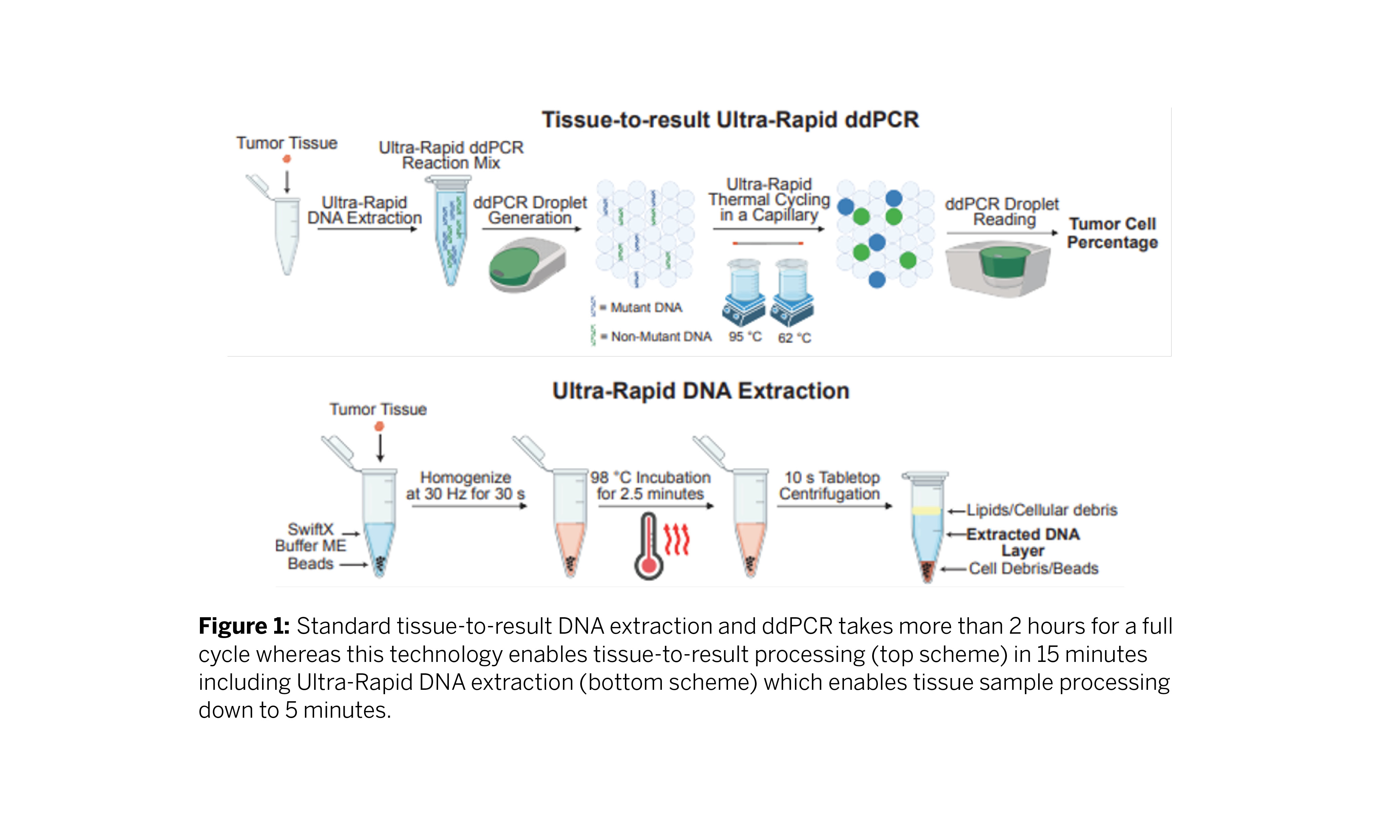Intraoperative Ultra Rapid Digital Droplet PCR to Guide Tumor Resection
Quick determination of the percentage of tumor cells and their molecular-genetic signature with a high sensitivity and specificity to guide surgical tumor resection.

Technology
NYU researchers have developed a new technique combining the speed of extreme PCR to the sensitivity and specificity of droplet digital PCR (ddPCR) with a new technology capable of quick detection of specific mutations in tumor samples to determine tumor cell percentage. Maximal surgical resection is a key therapeutic goal for many tumors for which the diagnosis and treatment depends on molecular-genetic data. However, there has previously been no method to determine the molecular-genetic subtype of a tumor nor to measure the tumor cell burden at the surgical margins with the rapid speed required intraoperatively to guide tumor resection. To address this gap, NYU researchers have developed an Ultra-Rapid droplet digital PCR (UR-ddPCR) which can be completed from tissue to result in 15 minutes or less and allows real-time analysis of DNA derived from tumors during surgery (Figure 1). Tumors frequently harbor one or more clonal mutations that are characteristic of one cancer type. UR-ddPCR allows intraoperative rapid identification of the presence of specific mutations during tumor resection, in order to identify the molecular-genetic subtype of a tumor and quantify the tumor cell percentage from tissue samples to guide tumor resection with unprecedented accuracy.
UR-ddPCR assays has been first demonstrated for mutations that are frequently found in low-grade gliomas and melanomas. The clinical feasibility of the technique has then been assessed by performing it intraoperatively in 13 glioma cases. UR-ddPCR can also conduct 4 assays in parallel, allowing samples from multiple margin locations to be analyzed simultaneously. Moreover, UR-ddPCR measurements can be combined with UR-stimulated histology intraoperatively to estimate tumor cell densities in addition to tumor cell percentage. UR-ddPCR, will enable novel point-of-care diagnostics and the development of molecularly-guided surgeries. UR-ddPCR measurements are fully concordant with standard ddPCR.
Background
Molecular-genetic analysis after tumor resection currently takes days to weeks and requires advanced laboratory staff and infrastructure. A technology combining molecular subtyping and tumor cell percentage quantification, and able to deliver results with high sensitivity and specificity in less than 15 minutes would be extremely useful in the operating room to guide tumor resection. Ultra-rapid histological methods can achieve this speed, but their results rely on indirect inference based on cell morphology that can be imprecise or incorrect. Extreme PCR is a method for conducting PCR in less than 30 seconds, but cannot readily determine mutant DNA fraction in a sample, which would be necessary for measuring tumor cell percentage. In contrast, droplet-digital PCR (ddPCR), in which a PCR reaction is partitioned into thousands of nanoliter-sized reactions, can measure tumor cell percentage with high sensitivity and specificity, but this technique takes too much time (~2 hours) to be used as an intraoperative tool.
Applications
- In-surgery real-time determination of the percentage of tumor cells based on their genetic signature to guide surgical resection.
- Possible combination with other methods for tumor analysis: UR-ddPCR can be combined with UR-stimulated histology.
- Possible adaptation of any quantitative PCR assay, for example for infectious diseases, for an ultra-rapid quantitative point-of-care diagnostic.
Advantages
- Real-time analysis: Quick determination of the percentage of tumor cell and their genetic signature during tumor resection.
- Fast and efficient: 15 minutes from tumor tissue to result.
- Novel reaction mix: Highly Sensitive and specific to detect mutations in tumor samples.
Developmental Status
NYU Langone Health researchers are collaborating with NYU Tandon School of Engineering to develop a microfluidic-based automated device for more rapid processing and profiling more samples and mutations in parallel.
Intellectual Property
NYU has filed a provisional patent covering the method of using UR-ddPCR on samples
-
expand_more mode_edit Authors (2)Gilad Evrony, MD, PhDDaniel Orringer, MD
-
expand_more library_books References (1)
- Zachary R. Murphy, Emilia C. Bianchini, Andrew Smith, Lisa I. Körner, Teresa Russell, David Reinecke, Yuxiu Wang, Matija Snuderl, Daniel A. Orringer, Gilad D. Evrony , Ultra Rapid Droplet Digital PCR Enables Intraoperative Tumor Quantification
-
expand_more cloud_download Supporting documents (2)Product brochureIntraoperative Ultra Rapid Digital Droplet PCR to Guide Tumor Resection.pdfMarketing BriefNYU - Intraoperative Ultra Rapid digital droplet PCR to Guide Tumor Resection - Marketing Brief - EVR01-03.pdf (108 KB)